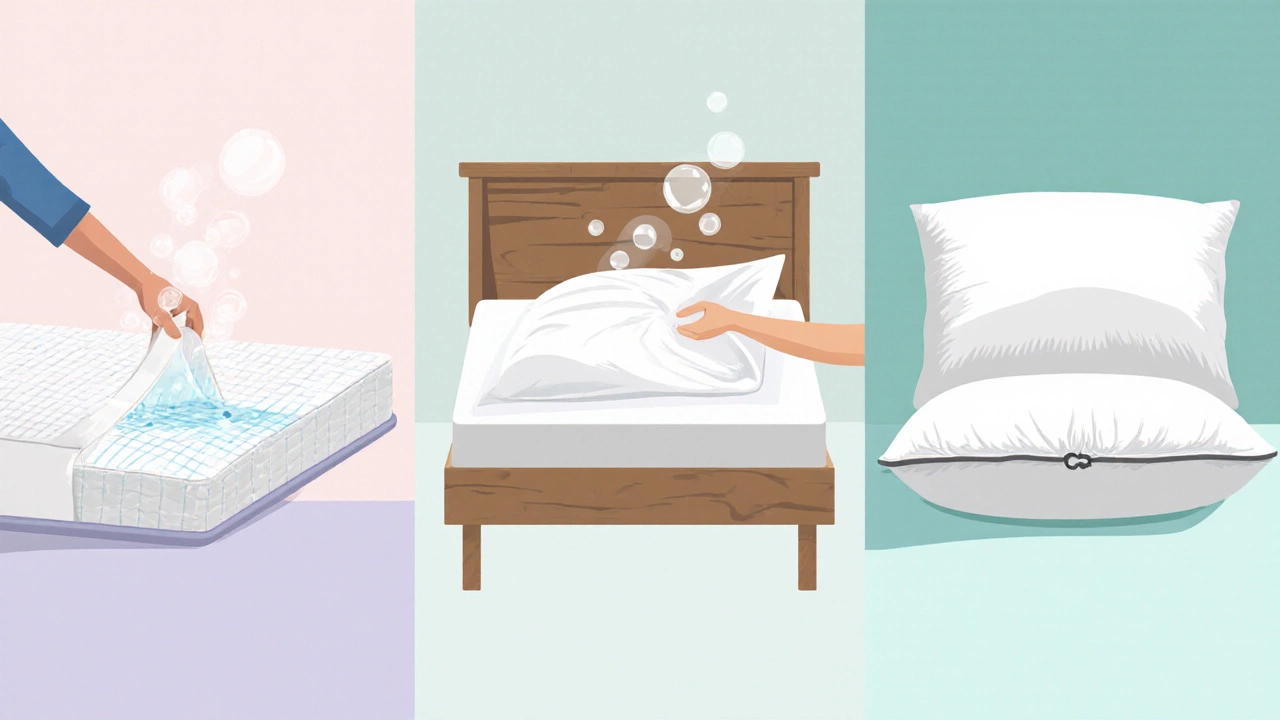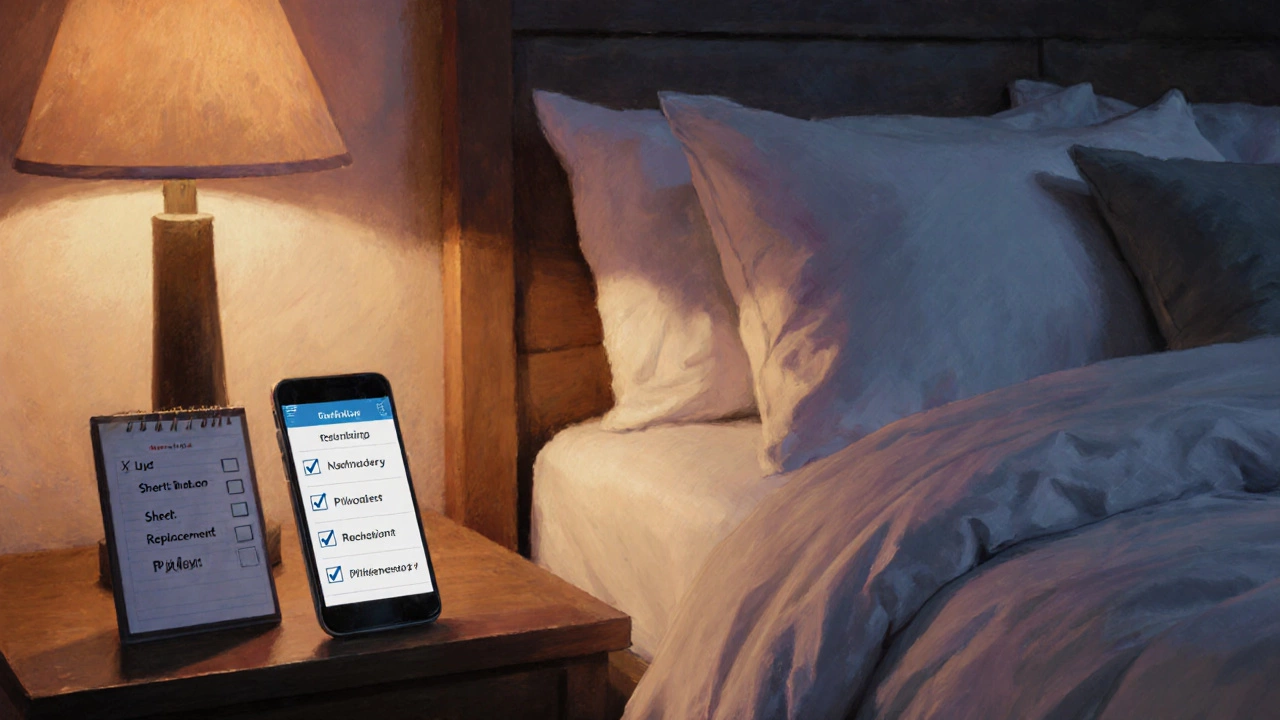Bedding Period Calculator
Key Takeaways
- A bedding period is the timeframe you keep the same mattress, sheets, and pillows before swapping or deep‑cleaning.
- Typical bedding periods range from 1 month for sheets to 7-10 years for mattresses.
- Factors like sleep hygiene, bedroom temperature, and allergies dictate how often you should refresh each item.
- Following a simple rotation schedule can extend the life of your mattress and keep your sleep space healthy.
- Regular care-vacuuming, airing out, and using protectors-helps you stick to the recommended periods without extra cost.
Ever wonder why some people say “change your sheets every week” while others keep a mattress for a decade? The answer lies in something called a bedding period is a defined span of time during which you use the same mattress, pillow, or sheet set before performing a major refresh such as rotation, deep cleaning, or replacement. Understanding the bedding period helps you keep your sleep space fresh, safe, and comfortable without throwing away perfectly good items.
Why a Bedding Period Matters
Sleep is the foundation of every day, yet most of us treat our bed like a background prop. A stale bedding period can lead to three real problems:
- Hygiene issues: Sweat, skin cells, and dust mites build up in sheets and mattress fibers. Over time they become a breeding ground for allergens.
- Comfort loss: Mattresses sag, pillows flatten, and sheets wear thin, which changes spinal alignment and can cause aches.
- Warranty risks: Many manufacturers void warranties if you don’t follow recommended care schedules.
By setting clear bedding periods, you protect your health, preserve the lifespan of each item, and stay within warranty terms.
Typical Bedding Periods for Common Items
Below is a quick reference for how long most bedroom essentials last before you should consider a refresh.
| Item | Suggested Period | When to Replace / Rotate | Tips to Extend Life |
|---|---|---|---|
| Sheets (cotton, polyester) | 1-3 months | Replace when they feel thin, develop holes, or retain odors. | Wash in warm water, line‑dry, use a gentle detergent. |
| Pillow (down, memory foam) | 1-2 years | Replace when it no longer springs back or causes neck pain. | Use a pillow protector, fluff daily, air out weekly. |
| Mattress (innerspring, hybrid) | 7-10 years | Rotate or flip every 6 months; replace when sagging >2 inches. | Use a mattress protector, keep bedroom cool, vacuum monthly. |
| Bed frame (wood, metal) | 10+ years | Replace if joints creak or frame bows. | Check screws quarterly, apply wood polish or rust inhibitor. |
| Blanket / comforter | 3-5 years | Replace when filler clumps or fabric thins. | Store in a breathable bag, dry‑clean only when needed. |

Factors That Influence Your Bedding Period
Not every household follows the same schedule. Here are the main variables that can shorten or lengthen each period.
- Sleep hygiene: Night sweats, pets on the bed, or eating in bed accelerate wear.
- Bedroom temperature: Warm rooms increase moisture, which speeds up mold and odor build‑up.
- Allergy season: If you’re prone to dust‑mite reactions, you may need to wash sheets more often.
- Material quality: High‑thread‑count cotton lasts longer than low‑grade blends.
- Usage frequency: Guest rooms that see occasional use can stretch the bedding period.
Take note of these factors when you set your own schedule. For example, a hot sleeper who loves night‑time reading in bed may want to swap sheets every month instead of the typical three.
How to Set Up a Simple Bedding Calendar
Creating a visual calendar keeps you from forgetting that six‑month mattress rotation.
- List each item with its recommended period (see the table above).
- Mark the start date-the day you bought or last deep‑cleaned the item.
- Calculate the next action date (e.g., “Rotate mattress on 2026‑04‑15”). \n
- Set reminders on your phone or a wall planner.
- Review quarterly to adjust for any changes in temperature or allergy symptoms.
This method takes less than five minutes a year but saves you from sore backs and costly replacements.
Common Mistakes and How to Avoid Them
Even with a plan, people slip up. Here are the most frequent errors and quick fixes.
- Skipping the mattress protector: Without a barrier, spills and sweat seep into the core, shortening the period. Invest in a breathable, waterproof protector.
- Washing sheets with harsh chemicals: Bleach damages fibers, causing holes sooner. Stick to mild detergents and avoid over‑drying.
- Ignoring pillow shape: A flat pillow can cause neck strain long before the 2‑year mark. Fluff daily and consider a dual‑side pillow for added support.
- Storing blankets in plastic bags: Traps moisture, leading to mildew. Use a cotton storage bag instead.

When to Break the Rules
Rules are guides, not commandments. Situations that demand a faster bedding period include:
- After a severe illness or flu-replace bedding to prevent re‑infection.
- Home remodeling that creates dust-air out and wash all linens within two weeks.
- Pets develop a habit of chewing or scratching-swap out the affected items immediately.
Conversely, a low‑usage guest room can safely stretch the sheet period to six months without compromising cleanliness.
Checklist: Your Bedding Period Routine
- ☑️ Review your bedding calendar each season.
- ☑️ Rotate or flip the mattress every 6 months.
- ☑️ Wash sheets and pillowcases at least once a month.
- ☑️ Replace pillows every 1-2 years.
- ☑️ Inspect mattress for sagging or lumps yearly.
- ☑️ Keep bedroom temperature between 60‑68°F (15‑20°C) for optimal humidity.
- ☑️ Use protectors on mattress, pillow, and comforter.
FAQs
How often should I rotate my mattress?
Most experts recommend rotating (head‑to‑foot) every six months. If you have a double‑sided innerspring, you can also flip it at the same interval.
Can I extend the life of my sheets by washing them less?
Washing less won’t help; it actually speeds up odor and bacterial build‑up. Instead, use a good quality detergent, wash in warm water, and avoid over‑drying to keep fibers strong.
What’s the best material for a long‑lasting pillow?
Memory foam and latex tend to keep their shape longer than down or polyester. Look for a pillow with a removable, washable cover for added hygiene.
Do mattress warranties require a specific bedding period?
Many warranties state that you must use a mattress protector and rotate the mattress as recommended. Failing to do so can void the warranty, so keep receipts of your care routine.
How can I tell if my mattress is beyond its bedding period?
If you notice a dip greater than 2 inches, persistent sagging, or increased back pain, it’s time to consider a replacement even if you’re under the 10‑year guideline.
Keeping a clear bedding period plan isn’t just about aesthetics; it’s a small habit that protects your health and saves money. Start with the checklist above, mark your calendar, and you’ll notice the difference the next time you crawl into bed.







